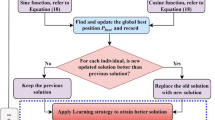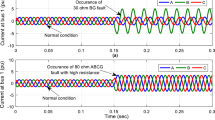Abstract
Recently, the electric power systems are operated relatively close to their operational limits due to worldwide deregulated electricity market policies. The power systems are being operated with high stress, and hence sufficient voltage stability margin is necessary to be managed to ensure secure operation of the power system. A particle swarm optimization-based support vector machine (SVM) approach for online monitoring of voltage stability has been proposed in this paper. The conventional methods for voltage stability monitoring are less accurate and highly time-consuming consequently, infeasible for online application. SVM is a powerful machine learning technique and widely used in power system to predict the voltage stability margin, but its performances depend on the selection of parameters greatly. So, the particle swarm optimization is applied to determine the parameter settings of SVM. The proposed approach uses bus voltage angle and reactive power load as the input vectors to SVM, and the output vector is the voltage stability margin index. The effectiveness of the proposed approach is tested using the IEEE 14-bus test system, IEEE 30-bus test system and the IEEE 118-bus test system. The results of the proposed PSO-SVM approach for voltage stability monitoring are compared with artificial neural networks and grid search SVM approach with same data set to prove its superiority.







Similar content being viewed by others
References
Ajjarapu V, Christy C (1992) The continuation power flow: a tool for steady state voltage stability analysis. IEEE Trans Power Syst 7(1):416–423
Balamurugan G, Aravindhababu P (2013) Online VAR support estimation for voltage stability enhancement. Electr Power Energy Syst 49:408–413
Bansilal, Thukaram D, Kashyap KH (2003) Artificial neural Network application to power system voltage stability improvement. In: Conference on convergent technologies for Asia-Pacific region, TENCON 2003, vol 1, no. 15–17, pp 53–57
Canizares CA, Alvarado FL (1993) Point of collapse and continuation methods for large AC/DC system. IEEE Trans Power Syst 8(1):1–8
Chiang HD, Flueck AJ, Shah KS, Balu N et al (1995) CPFLOW: a practical tool for tracing power system steady-state stationary behavior due to load and generation variations. IEEE Trans Power Syst 10(2):623–634
Chung CY, Chung TS, Yu CW, Lin XJ (2004) Cost-based reactive power pricing with voltage security consideration in restructured power systems. Int J Electr Power Syst Res 70(2):85–91
Cortes C, Vapnik V (1995) Support-vector networks. Mach Learn 20(3):273–297
Drucker H, Burges Christopher JC, Kaufman L, Smola Alexander J, Vapnik V (1996) Support vector regression machines. Adv Neural Inf Process Syst 9:155–161
Duan K, Keerthi SS, Poo AN (2003) Evaluation of simple performance measures for tuning SVM hyperparameters. Neurocomputing 51:14–59
Fu YY, Wu CJ, Jeng TJ, Ko CN (2009) Identification of MIMO systems using radial basis function networks with hybrid learning algorithm. Appl Math Comput 213:184–196
Kalyani S, Swarup KS (2013) Pattern analysis and classification for security evaluation in power networks. Int J Electr Power Energy Syst 44(1):547–560
Keerthi SS, Lin CJ (2003) Asymptotic behaviors of support vector machines with Gaussian kernel. Neural Comput 15(7):1667–1689
Kennedy J, Eberhart R (1995) Particle swarm optimization. In: Proceedings of the IEEE international conference on neural networks 1995, pp 1942–1948
Kerdchuen T, Ongsakul W (2009) Optimal placement of PMU and RTU by hybrid genetic algorithm and simulated annealing for multiarea power system state estimation. GMSARN Int J 3(1):7–12
Kundur P (1994) Power system stability and control. McGraw-Hill Education, New York
Milano F (2009) A MATLAB toolbox for electric power system analysis and simulation. http://www.uclm.es/area/gsee/web/Federico/psat.html. Accessed 12 Dec 2014
Miranda GJ (2003) Be prepared! [power industry deregulation]. IEEE Ind Appl Mag 9(2):12–20
Moghavvemi M, Omar FM (1998) Technique for contingency monitoring and voltage collapse prediction. IEE Proc Gener Transm Distrib 145(6):634–640
Musirin I, Rahman TKA (2002) On-line voltage stability based contingency ranking using fast voltage stability index (FVSI). In: Proceedings of the IEEE/PES transmission and distribution conference on exhibition, Asia Pacific vol 2, pp 1118–1123
Naganathan GS, Babulal CK (2014) Voltage stability margin assessment using multilayer feed forward neural network. Appl Mech Mater 573:661–667
Power System Test Archive-UWEE (University of Washington). http://www.ee.washington.edu/research/pstca. Accessed 22 July 2014
Sajan KS, Kumar V, Tyagi B (2015) Genetic algorithm based support vector machine for on-line voltage stability monitoring. Electr Power Energy Syst 13:200–208
Smola AJ, Schölkopf B (1998) A tutorial on support vector regression. University of London, UK
Suganyadevi MV, Babulal CK (2009) Estimating of loadability margin of a power system by comparing voltage stability indices. In: Proceeding of IEEE on international conference on control, automation, communication and energy conservation, 4–6 June 2009
Suganyadevi MV, Babulal CK (2014) Support vector regression model for the prediction of loadability margin of a power system. Appl Soft Comput 24(3):304–315
Suganyadevi MV, Babulal CK, Kalyani S (2014) Assessment of voltage stability margin by comparing various support vector regression models. Soft Comput 20(2):807–818
Taylor CW (1994) Power system voltage stability. McGraw-Hill Education, New York
VanCutsem T, Vournas C (1998) Voltage stability of electric power systems. Kluwer Academic Publishers, Norwell
Yoshida H, Kawata K, Fukuyama Y, Nakanishi Y, Takayamaa S (2000) A particle swarm optimization for reactive power and voltage control considering voltage security assessment. IEEE Trans Power Syst 15:1232–1239
Zhou Debbie Q, Annakkage UD, Rajapakse Athula D (2010) Online monitoring of voltage stability margin using an artificial neural network. IEEE Trans Power Syst 25(3):1566–1574
Author information
Authors and Affiliations
Corresponding author
Ethics declarations
Conflict of interest
This section is to certify that we have no potential conflict of interest.
Ethical approval
This article does not contain any studies with human participants or animals performed by any of the authors.
Additional information
Communicated by V. Loia.
Rights and permissions
About this article
Cite this article
Naganathan, G.S., Babulal, C.K. Optimization of support vector machine parameters for voltage stability margin assessment in the deregulated power system. Soft Comput 23, 10495–10507 (2019). https://doi.org/10.1007/s00500-018-3615-x
Published:
Issue Date:
DOI: https://doi.org/10.1007/s00500-018-3615-x




